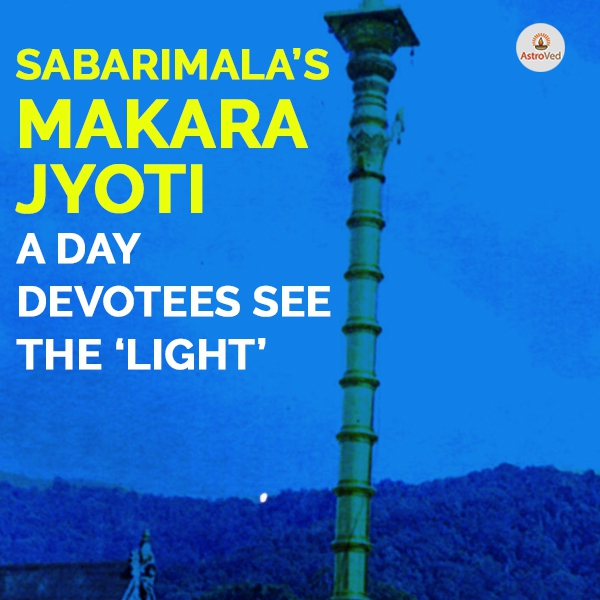The Untold Truth about Makara Jyothi
Makara Jyothi
The very mention of the term Makara Jyothi is enough to remind one of Lord Ayyappa of the famed hill temple Sabarimala and the traditional worship that the devotees undertake for him. Yes, there is no denying the fact that it is the Sabarimala pilgrimage and the Ayyappa worship that has given tremendous prominence to Makara Jyothi. And so much so that this event itself is referred to in many places as the Sabarimala Makara Jyothi. Thus, Makara Jyothi remains inseparable from Ayyappa worship but still has its own astronomical and religious significance. Incidentally, Makara Vilakku refers to a slightly different phenomenon, though both Makara Jyothi and Makara Vilakku are observed on the same day in the holy Sabarimala shrine.
Here, let us try to understand the phenomenon of Makara Jyothi in some detail.

What Does it Mean?
'Makara' or Makaram refers to the zodiac sign Capricorn, which comes 10th in the order of the 12 zodiac signs. 'Jyothi' in Sanskrit means the flame or light. 'Makara Jyothi' is thus 'the light of Capricorn.'
The zodiac is divided into 12 signs, and these are known as the Rasis or the zodiac signs. The Sun that is traveling in space appears to be moving through these signs, one after the other. He takes one year to make a complete round of the zodiac, and in the process spends about 30 or 31 days in a sign, before moving on to the next zodiac sign. This period corresponds to a month as per many Indian calendars. Typically, this month starts around the middle of an English month and ends around the same time in the following month.
Makara Sankranthi
This way, the Sun moves into Makara Rasi, the zodiac sign Capricorn in the middle of January, generally on the 14th or the 15th. This day of Sun's entry into Makara is held as very auspicious when people take holy baths, perform austerities, and offer special prayers to Sun God and other deities. This day is also celebrated throughout the country as Makara Sankranthi. Different regions and states of the country also observe this occasion under various names and celebrate it as per their customs and tradition. For instance, this day marks the harvest festival 'Pongal' in Tamil Nadu and is celebrated with great enthusiasm.
Makara Sankranthi also signals the beginning of the Sun's northward journey in space and is known as Uttarayana. This period of 6 months lasts from mid-January to mid-July every year.
As the Sun enters Makara Rasi, it starts shining from that sign and showering its light on the world. This phenomenon is regarded as Makara Jyothi. Incidentally, Makara Jyothi 2020 falls on 15th January this year.
Sabarimala and Makara Jyothi
But as already seen, Makara Jyothi holds a much deeper religious significance and is very closely associated with the famous temple of Lord Ayyappa of Sabarimala in the state of Kerala. The Makara Jyothi day is regarded perhaps as the most auspicious occasion in the 2 months long festive season of this highly popular hill temple. It is also considered the most important event in the annual Sabarimala pilgrimage undertaken by lakhs of devotees from all over the country and the world.
Further, it is traditionally believed that the Sun's movement into Makara Rasi gives rise to a spark of light in the sky. This first ray of the Sun after it moves into Makara Rasi is held as a divine occurrence and is worshipped by the people with reverence as Makara Jyothi. It is also the belief of the Ayyappa devotees that this light represents the Lord himself, who appears on the special occasion to shower his blessings on his devotees. This Makara Jyothi appears in the sky around the sunset time in the evening of Makara Shankaranthi, that is, at about 6 or 6.30 pm.
The Fact of the Matter
But astronomy offers its own explanation for this celestial phenomenon. This light, which is shining bright on the horizon and above the Sabarimala mountains, is, in reality, the luminous star Sirius, which is located in the star constellation Canis Major. This is thus a natural, aerial occurrence, which is visible in those mountainous regions around mid-January time. But the devouts believe this as the celestial lighting that happens on the auspicious occasion of Makara Shankaranthi and worship it as Makara Jyothi.
As Sabarimala Makara Jyothi occupies a pride of place in Lord Ayyappa worship, the devout may plan for the Sabarimala pilgrimage for Makara Jyothi 2020, offer prayers to the Lord and receive his blessings.



















